| |||||||||||||||||
Tuesday, August 2, 2011
Politics News & Analysis: White House, congressional leaders reach debt-limit deal
Monday, August 1, 2011
10 Top Facebook Pages and Why They’re Successful By Amy Porterfield
Does your business have a Facebook page? Have you ever wondered what successful Facebook page owners are doing right? Well, look no further.
This article examines 10 of the top Facebook pages from brands you’ll likely recognize. Regardless of the size of your business, you’lldiscover great ideas that will help you take your Facebook experience to the next level.
Each of these pages has incorporated unique features that have attracted hundreds of thousands (sometimes millions!) of fans and attracted the notice of major media publications. That’s a pretty big feat, considering there are thousands of new pages popping up on Facebook daily!
There is no need to reinvent the wheel. Instead, check out what others are doing and tweak these strategies to make them your own!
#1: Red Bull
The team behind the Red Bull page is extremely in tune with their target audience. This is evidenced in their custom apps and unique content throughout their page.
Red Bull knows what their audience will respond to best and they deliver it.For example, they’ve created a series of online games for their fans, aptly called the “Procrastination Station.” The games are geared toward sports and high-impact competitions.
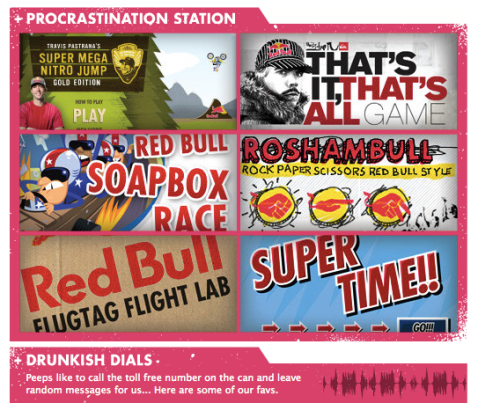
In addition, Red Bull created a web TV program that’s highlighted on their Facebook page. There are multiple segments, many spotlighting the lives of their sponsored athletes. Not only is the web TV show a great way to align with celebrity athletes, but it is also a way to incorporate video into the page, thereby giving the audience another way to interact.

Another smart feature of Red Bull’s page is their welcome tab. When a non-fan lands on their page, he or she sees the image below. Red Bull creatively encourages fans to “Like” their page with an attention-grabbing image. Also, they only put one thing on their welcome tab, making it very clear what they want to happen. When you add too much to your welcome tab, your fans will get confused and likely not take any action. Less is more. Stick to one call to action.
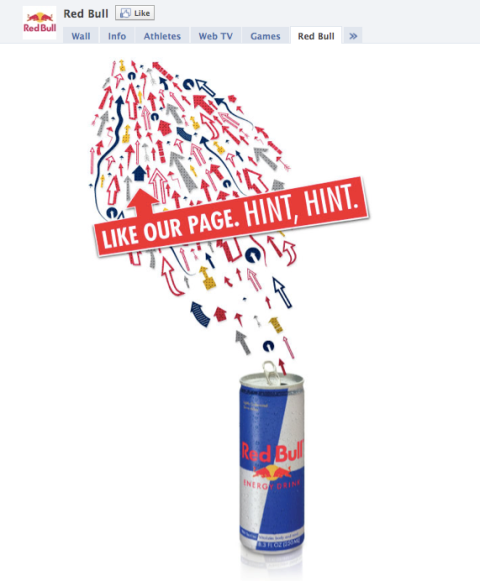
Tip: One area you might want to consider spending a little money on is creative design for your page. Design, when done right, makes a great first impression for non-fans. Also, when you design your Facebook page, pay close attention to your call to action, specifically for the “Like” button. What can you do to grab the attention of your new viewer and encourage him or her to click on your “Like” button quickly? Red Bull’s creative design on their welcome tab does just that!
#2: Burt’s Bees
One of the best features on the Burt’s Bees page is their use of photos and video. They use the photos and videos to give a behind-the-scenes view of their company and products.
In the image below, notice how Burt’s Bees not only mentions the type of ingredients used, but they also suggest their ingredients are safe and they welcome all visitors into their lab. This is a great example of a way to promote your company and products, while adding value in the form of interesting details.

Tip: We all have something unique about our products or services and Facebook is one of the best places to highlight this. How can you incorporate video or images to help you stand out from your competition?
#3: Uno Chicago Grill
Uno Chicago Grill has taken full advantage of the Facebook app FBML to highlight their menu options in an extremely appealing way. They have many tabs dedicated to specific areas of their menu and use imagery to entice their fans. In addition, on their welcome tab they link to the most important areas of their website, including locations and online ordering options. When non-fans come to their page for the first time, they get an instant snapshot of Uno’s offerings.
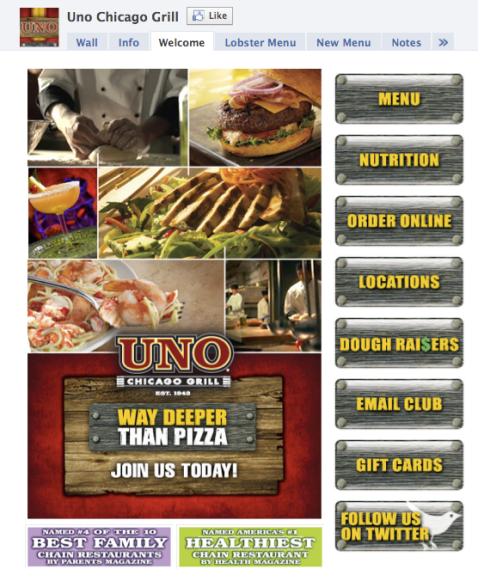
 In addition, Uno has incorporated a Fan of the Week conteston their Facebook page. Fans get their photo posted directly on the profile image of the restaurant’s wall.
In addition, Uno has incorporated a Fan of the Week conteston their Facebook page. Fans get their photo posted directly on the profile image of the restaurant’s wall.
This is great exposure for the fan, making it a fun activity to participate in.
To take it one step further, Uno does something unique with their Fan of the Week contest—they ask fans to post photos of themselves while at an Uno restaurant, thereby encouraging fans to come in and dine.
This is a great way to bring their online fans into their brick-and-mortar establishment!

Tip: If you have a brick-and-mortar establishment, think of creative ways to entice your fans to visit in person. Contests, promotions and special offers are all great ways to invite new fans to come in and check things out!
#4: LiveScribe
LiveScribe has incorporated two features into their page to help them sell more products and cut back on support calls.
First, they’ve created a savvy storefront as one of their tabs. Not only can you buy directly from the Facebook page, but you can also tweet about their products and post about them on your Facebook wall. These two options help create greater exposure for LiveScribe’s products. When your friends see that you’re posting about a new product, it’s natural for them to want to know more.
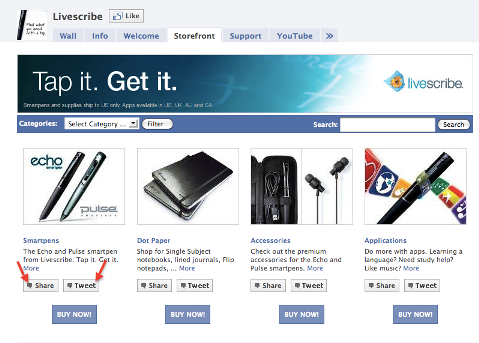
In addition, LiveScribe has incorporated a support desk directly into their Facebook page. As you can see below, you can ask a question, share an idea, report a problem or even give praise directly from their Facebook page. What’s even more important is that others can see these posts. Fans and potential buyers can then go to this tab to get answers or see what others are saying about the products.
It’s another great way to educate fans about your products and services. In addition, this tool can cut down service calls when executed correctly, saving your company time and money.
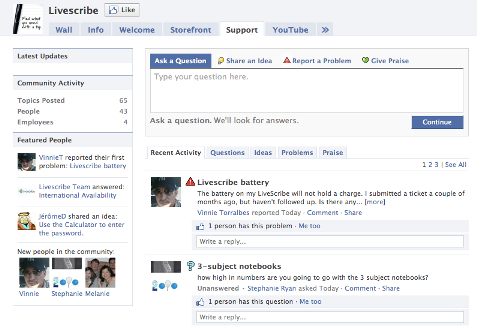
Tip: If you’re providing a product or service, consider incorporating a support feature to your page. It’s common for customers to use social media sites to post questions or complaints. If you provide a designated place for support, you’re likely to keep your customers happy and turn them into repeat buyers!
#5: Toy Story 3
Toy Story 3 has done an exceptional job of making their page both fun and functional. The fun factor is expressed in their new application, Toy Creator, where you can turn yourself into an animated toy. Both kids and adults can get in on the action and thenshare their new creation on their Facebook wall (yet another viral exposure opportunity!).
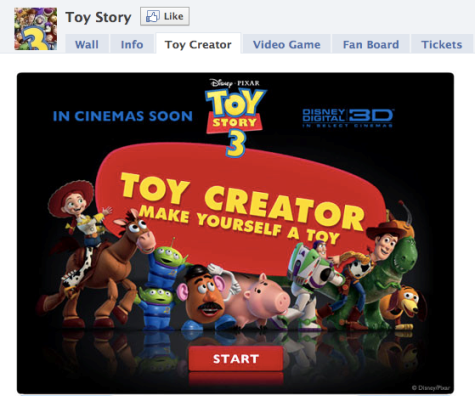
To make their page functional, they’ve built a tab where you can purchase movie tickets without ever leaving Facebook. This makes ticket buying easy and fast for their fans.
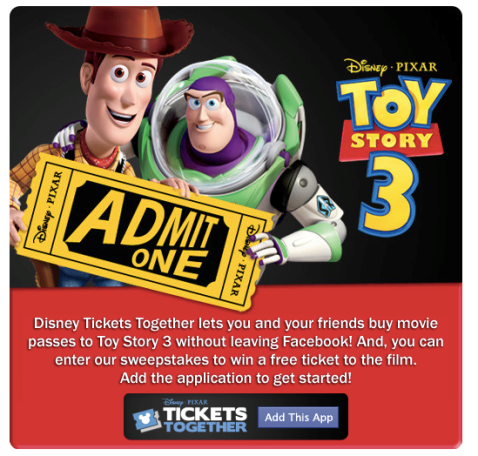
Tip: Keep your fans inside Facebook as much as possible. Bring your content, unique experiences and buying opportunities to them instead of making fans leave the site to interact with your business. Your chances for greater interactions and a bigger return on investment will dramatically increase the longer you keep them on your page.
#6: Coca-Cola
Coca-Cola has secured their spot at the top of many best-of-the-best Facebook page lists due to their innovative promotions and fun, interactive features.
Their latest promotion is the Summer Snapshot contest, where they encourage their fans to take photos with the summer Coca-Cola cans. Not only does this get fans involved with their page, but the contest also incorporates photos of their products with fans.
Photos are viewed more than anything else on Facebook. They go viral quickly because when a fan posts a photo, that photo is then sent out to the news feeds of all of their friends. Hundreds of thousands of potentially new fans will see these photos.
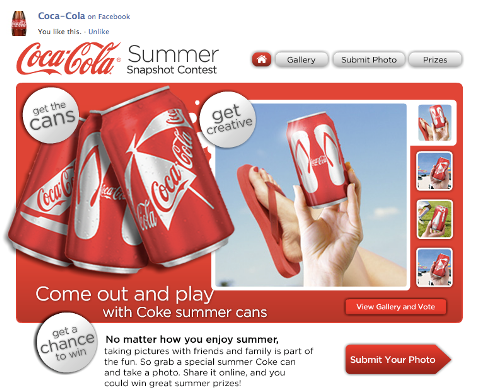
Here’s an example of a photo a fan posted for the Coca-Cola contest. Notice how others can vote on the photos? This allows everyone to get in on the fun.
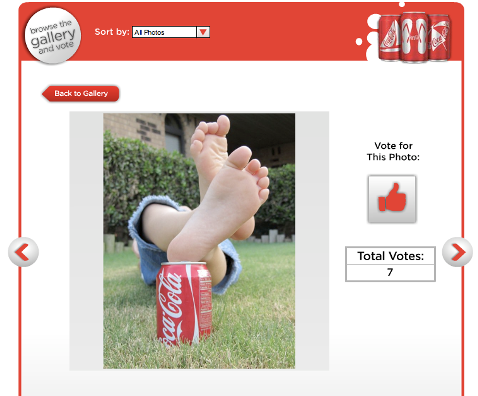
Tip: When creating a contest, keep it simple. The less your fans need do to enter, the better. Make it easy, fun and make sure to incorporate a sharing component so your contest spreads virally.
#7: Oreo
Oreo does a fantastic job of creating unique experiences for their fans. Oreo knows that their cookies have been part of many people’s lives since childhood and they use this angle to create nostalgia with their fans. And it’s working for them because they have over 8 million fans to date!
One of their latest campaigns is their “Back to School Memories” campaign where they ask their fans to share their memories and photos directly on their Facebook page. By offering unique experiences like Oreo has done with their back to school campaign, brands create a connection to the fans, who become loyal followers and keep coming back for more.
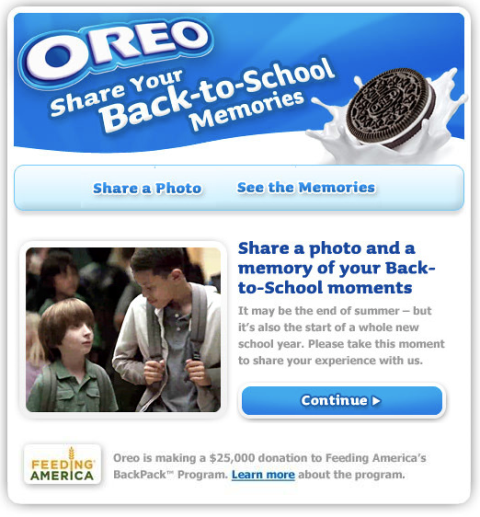
Tip: You’ll get a much greater response when you ask your fans to share something about themselves. Ask them their thoughts, opinions and feedback and you’ll be pleasantly surprised how quickly they start talking!
#8: Jones Soda
Jones Soda does a great job of incorporating many different ways for their fans to interact with their page. Not everyone communicates the same way, so providing multiple options is a smart strategy.
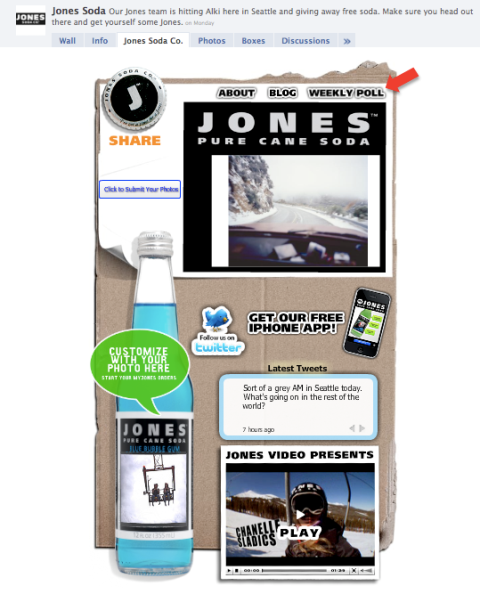
Specifically, Jones Soda does a weekly poll directly from their welcome tab. Polls are a great way to learn more about your audience as well as a fun strategy to get them to interact with your page.
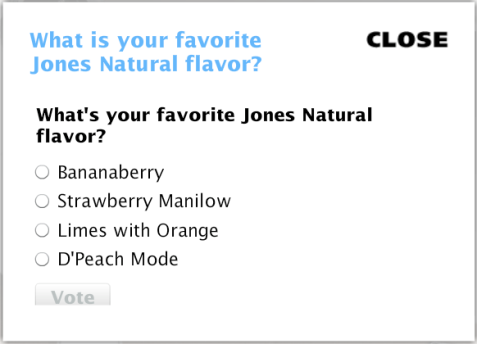
Tip: Think of different ways to get your fans to engage with you. Polls, contests, questions, iPhone apps and videos are just a few different ways to reach your fans. All fans are different; make sure to provide options.
#9: The Twilight Saga
No matter if you have seen the movies or not, you can’t deny that the Twilight Saga is hot. There are two strategies they’ve launched on their Facebook page that you can model for your own page.
First, they’ve created a “Tweet Sweeps,” where they encourage fans to tweet about the movies for a chance to win movie tickets. The best strategy with this type of contest is to tell fans specifically what to tweet so there is no confusion and they can take action quickly. Check out how they’ve done this in the image below:
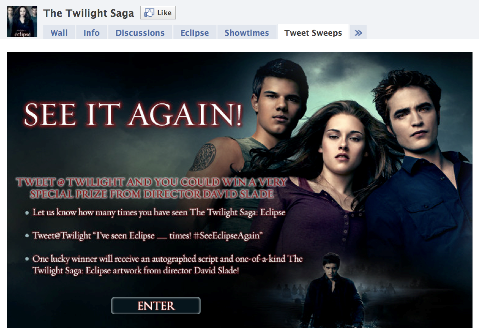
In addition, the Twilight Saga page has taken advantage of the “Discussion” tab where fans can post topics of discussion and all fans can join in and comment. The discussion tab creates a great sense of community and dramatically increases the engagement on the page.
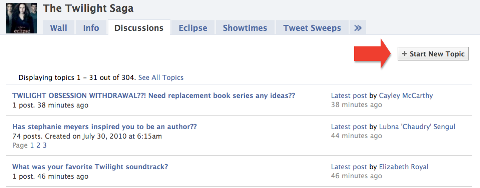
Tip: To encourage more conversation among fans on your page, start a few discussion streams to get people talking. Once this takes off, your fans will continue to post discussion topics on their own and the page engagement will grow organically.
#10: Travel Channel
The Travel Channel has done something unique on their page that’s worth checking out. They’ve created a space for their fans to share how Facebook has played a part in their travel experiences. You can post your own story or just read what others have posted. It’s a creative way to get people with similar interests to engage with your page.
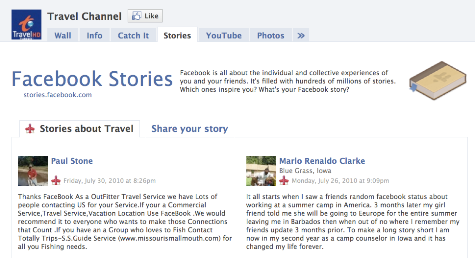
Tip: Facebook Stories can be incorporated on your page as well. Go here to see how it works and check out the different story themes offered.
What do you think about the above Facebook pages? Have you tried any of these techniques with success? Let us know! Please leave your comments below.
10 Top Facebook Pages and Why They’re Successful By Amy Porterfield
http://www.socialmediaexaminer.com/top-10-facebook-pages/
Monday, July 11, 2011
In Defense of Antidepressants (Could this be true?) By PETER D. KRAMER
IN terms of perception, these are hard times for antidepressants. A number of articles have suggested that the drugs are no more effective than placebos.
Last month brought an especially high-profile debunking. In an essay in The New York Review of Books, Marcia Angell, former editor in chief of The New England Journal of Medicine, favorably entertained the premise that “psychoactive drugs are useless.” Earlier, a USA Today piece about a study done by the psychologist Robert DeRubeis had the headline, “Antidepressant lift may be all in your head,” and shortly after, a Newsweek cover piece discussed research by the psychologist Irving Kirsch arguing that the drugs were no more effective than a placebo.
Could this be true? Could drugs that are ingested by one in 10 Americans each year, drugs that have changed the way that mental illness is treated, really be a hoax, a mistake or a concept gone wrong?
This supposition is worrisome. Antidepressants work — ordinarily well, on a par with other medications doctors prescribe. Yes, certain researchers have questioned their efficacy in particular areas — sometimes, I believe, on the basis of shaky data. And yet, the notion that they aren’t effective in general is influencing treatment.
For instance, not long ago, I received disturbing news: a friend had had a stroke that paralyzed the right side of his body. Hoping to be of use, I searched the Web for a study I vaguely remembered. There it was: a group in France had worked with more than 100 people with the kind of stroke that affected my friend. Along with physiotherapy, half received Prozac, and half a placebo. Members of the Prozac group recovered more of their mobility. Antidepressants are good at treating post-stroke depression and good at preventing it. They also help protect memory. In stroke patients, antidepressants look like a tonic for brain health.
When I learned that my friend was not on antidepressants, I suggested he raise the issue with his neurologists. I e-mailed them the relevant articles. After further consideration, the doctors added the medicines to his regimen of physical therapy.
Surprised that my friend had not been offered a highly effective treatment, I phoned Robert G. Robinson at the University of Iowa’s department of psychiatry, a leading researcher in this field. He said, “Neurologists tell me they don’t use an antidepressant unless a patient is suffering very serious depression. They’re influenced by reports that say that’s all antidepressants are good for.”
Critics raise various concerns, but in my view the serious dispute about antidepressant efficacy has a limited focus. Do they work for the core symptoms (such as despair, low energy and feelings of worthlessness) of isolated episodes of mild or moderate depression? The claim that antidepressants do nothing for this common condition — that they are merely placebos with side effects — is based on studies that have probably received more ink than they deserve.
The most widely publicized debunking research — the basis for the Newsweek and New York Review pieces — is drawn from data submitted to the Food and Drug Administration in the late 1980s and the 1990s by companies seeking approval for new drugs. This research led to its share of scandal when a study in The New England Journal of Medicine found that the trials had been published selectively. Papers showing that antidepressants work had found their way into print; unfavorable findings had not.
In his book “The Emperor’s New Drugs: Exploding the Antidepressant Myth,” Dr. Kirsch, a psychologist at the University of Hull in England, analyzed all the data. He found that while the drugs outperformed the placebos for mild and moderate depression, the benefits were small. The problem with the Kirsch analysis — and none of the major press reports considered this shortcoming — is that the F.D.A. material is ill suited to answer questions about mild depression.
As a condition for drug approval, the F.D.A. requires drug companies to demonstrate a medicine’s efficacy in at least two trials. Trials in which neither the new drug nor an older, established drug is distinguishable from a placebo are deemed “failed” and are disregarded or weighed lightly in the evaluation. Consequently, companies rushing to get medications to market have had an incentive to run quick, sloppy trials.
Often subjects who don’t really have depression are included — and (no surprise) weeks down the road they are not depressed. People may exaggerate their symptoms to get free care or incentive payments offered in trials. Other, perfectly honest subjects participate when they are at their worst and then spontaneously return to their usual, lower, level of depression.
THIS improvement may have nothing to do with faith in dummy pills; it is an artifact of the recruitment process. Still, the recoveries are called “placebo responses,” and in the F.D.A. data they have been steadily on the rise. In some studies, 40 percent of subjects not receiving medication get better.
The problem is so big that entrepreneurs have founded businesses promising to identify genuinely ill research subjects. The companies use video links to screen patients at central locations where (contrary to the practice at centers where trials are run) reviewers have no incentives for enrolling subjects. In early comparisons, off-site raters rejected about 40 percent of subjects who had been accepted locally — on the ground that those subjects did not have severe enough symptoms to qualify for treatment. If this result is typical, many subjects labeled mildly depressed in the F.D.A. data don’t have depression and might well respond to placebos as readily as to antidepressants.
Nonetheless, the F.D.A. mostly gets it right. To simplify a complex matter: there are two sorts of studies that are done on drugs: broad trials and narrow trials. Broad trials, like those done to evaluate new drugs, can be difficult these days, because many antidepressants are available as generics. Who volunteers to take an untested remedy? Research subjects are likely to be an odd bunch.
Narrow studies, done on those with specific disorders, tend to be more reliable. Recruitment of subjects is straightforward; no one’s walking off the street to enter a trial for stroke patients. Narrow studies have identified many specific indications for antidepressants, such as depression in neurological disorders, including multiple sclerosis andepilepsy; depression caused by interferon, a medication used to treat hepatitis and melanoma; and anxiety disorders in children.
New ones regularly emerge. The June issue of Surgery Today features a study in which elderly female cardiac patients who had had emergency operations and were given antidepressants experienced less depression, shorter hospital stays and fewer deaths in the hospital.
Broad studies tend to be most trustworthy when they look at patients with sustained illness. A reliable finding is that antidepressants work for chronic and recurrent mild depression, the condition called dysthymia. More than half of patients on medicine get better, compared to less than a third taking a placebo. (This level of efficacy — far from ideal — is typical across a range of conditions in which antidepressants outperform placebos.) Similarly, even the analyses that doubt the usefulness of antidepressants find that they help with severe depression.
In fact, antidepressants appear to have effects across the depressive spectrum. Scattered studies suggest that antidepressants bolster confidence or diminish emotional vulnerability — for people with depression but also for healthy people. In the depressed, the decrease in what is called neuroticism seems to protect against further episodes. Because neuroticism is not a core symptom of depression, most outcome trials don’t measure this change, but we can see why patients and doctors might consider it beneficial.
Similarly, in rodent and primate trials, antidepressants have broad effects on both healthy animals and animals with conditions that resemble mood disruptions in humans.
One reason the F.D.A. manages to identify useful medicines is that it looks at a range of evidence. It encourages companies to submit “maintenance studies.” In these trials, researchers take patients who are doing well on medication and switch some to dummy pills. If the drugs are acting as placebos, switching should do nothing. In an analysis that looked at maintenance studies for 4,410 patients with a range of severity levels, antidepressants cut the odds of relapse by 70 percent. These results, rarely referenced in the antidepressant-as-placebo literature, hardly suggest that the usefulness of the drugs is all in patients’ heads.
The other round of media articles questioning antidepressants came in response to a seemingly minor study engineered to highlight placebo responses. One effort to mute the placebo effect in drug trials involves using a “washout period” during which all subjects get a dummy pill for up to two weeks. Those who report prompt relief are dropped; the study proceeds with those who remain symptomatic, with half getting the active medication. In light of subject recruitment problems, this approach has obvious appeal.
Dr. DeRubeis, an authority on cognitive behavioral psychotherapy, has argued that the washout method plays down the placebo effect. Last year, Dr. DeRubeis and his colleagues published a highly specific statistical analysis. From a large body of research, they discarded trials that used washouts, as well as those that focused on dysthymia or subtypes of depression. The team deemed only six studies, from over 2,000, suitable for review. An odd collection they were. Only studies using Paxil and imipramine, a medicine introduced in the 1950s, made the cut — and other research had found Paxil to be among the least effective of the new antidepressants. One of the imipramine studies used a very low dose of the drug. The largest study Dr. DeRubeis identified was his own. In 2005, he conducted a trial in which Paxil did slightly better than psychotherapy and significantly better than a placebo — but apparently much of the drug response occurred in sicker patients.
Building an overview around your own research is problematic. Generally, you use your study to build a hypothesis; you then test the theory on fresh data. Critics questioned other aspects of Dr. DeRubeis’s math. In a re-analysis using fewer assumptions, Dr. DeRubeis found that his core result (less effect for healthier patients) now fell just shy of statistical significance. Overall, the medications looked best for very severe depression and had only slight benefits for mild depression — but this study, looking at weak treatments and intentionally maximized placebo effects, could not quite meet the scientific standard for a firm conclusion. And yet, the publication of the no-washout paper produced a new round of news reports that antidepressants were placebos.
In the end, the much heralded overview analyses look to be editorials with numbers attached. The intent, presumably to right the balance between psychotherapy and medication in the treatment of mild depression, may be admirable, but the data bearing on the question is messy.
As for the news media’s uncritical embrace of debunking studies, my guess, based on regular contact with reporters, is that a number of forces are at work. Misdeeds — from hiding study results to paying off doctors — have made Big Pharma an inviting and, frankly, an appropriate target. (It’s a favorite of Dr. Angell’s.) Antidepressants have something like celebrity status; exposing them makes headlines.
It is hard to locate the judicious stance with regard to antidepressants and moderate mood disorder. In my 1993 book, “Listening to Prozac,” I wrote, “To my mind, psychotherapy remains the single most helpful technology for the treatment of minor depression and anxiety.” In 2003, in “Against Depression,” I highlighted research that suggested antidepressants influence mood only indirectly. It may be that the drugs are “permissive,” removing roadblocks to self-healing.
That model might predict that in truth the drugs would be more effective in severe disorders. If antidepressants act by usefully perturbing a brain that’s “stuck,” then people who retain some natural resilience would see a lesser benefit. That said, the result that the debunking analyses propose remains implausible: antidepressants help in severe depression, depressive subtypes, chronic minor depression, social unease and a range of conditions modeled in mice and monkeys — but uniquely not in isolated episodes of mild depression in humans.
BETTER-DESIGNED research may tell us whether there is a point on the continuum of mood disorder where antidepressants cease to work. If I had to put down my marker now — and effectively, as a practitioner, I do — I’d bet that “stuckness” applies all along the line, that when mildly depressed patients respond to medication, more often than not we’re seeing true drug effects. Still, my approach with mild depression is to begin treatments with psychotherapy. I aim to use drugs sparingly. They have side effects, some of them serious. Antidepressants help with strokes, but surveys also show them to predispose to stroke. But if psychotherapy leads to only slow progress, I will recommend adding medicines. With a higher frequency and stronger potency than what we see in the literature, they seem to help.
My own beliefs aside, it is dangerous for the press to hammer away at the theme that antidepressants are placebos. They’re not. To give the impression that they are is to cause needless suffering.
As for my friend, he had made no progress before his neurologists prescribed antidepressants. Since, he has shown a slow return of motor function. As is true with much that we see in clinical medicine, the cause of this change is unknowable. But antidepressants are a reasonable element in the treatment — because they do seem to make the brain more flexible, and they’ve earned their place in the doctor’s satchel.
Peter D. Kramer is a clinical professor of psychiatry at Brown University.
Wednesday, July 6, 2011
A América e a Europa estão a ir ao fundo – Riscos para todo o mundo
Em Washington discute-se o tecto da dívida; em Bruxelas olha-se para o fosso da dívida. Mas o problema é mais ou menos o mesmo.
Os EUA e a União Europeia andam com as finanças públicas fora de controlo e os seus sistemas políticos mostram-se demasiado disfuncionais para resolver o problema. A América e a Europa estão no mesmo barco, um barco que se está a afundar.
De ambos os lados do Atlântico ficou agora bem patente que grande parte do crescimento económico registado nos anos que precederam a crise se ficou a dever a esse ‘boom' insustentável e perigoso do crédito. Nos EUA as vítimas da crise foram as pessoas que adquiriram casa própria; na Europa foram países inteiros como a Grécia e a Itália, países que aproveitaram as baixas taxas de juro para contraírem empréstimos de uma forma que se revelaria insustentável.
O choque financeiro de 2008 e tudo o que se seguiu foi um rude golpe para as finanças públicas quando a dívida pública começou a subir vertiginosamente. E tanto na Europa como nos EUA a este choque vieram juntar-se pressões demográficas, pressões que assumem cada vez mais a forma de pressões orçamentais, numa altura em que a geração dos ‘baby boomers' começa a reformar-se.
E, em ambos os lados do Atlântico, a crise económica está a dividir os políticos, o que torna ainda mais difícil encontrar soluções racionais para o problema da dívida. E, por outro lado, começamos a assistir também à ascensão de movimentos populistas, como é o caso do Tea Party nos EUA, do partido Dutch Freedom na Holanda ou do partido True Finns na Europa.
A ideia de que a Europa e os EUA representam duas faces da mesma crise tem sido lenta a assimilar, isto porque, durante muitos anos, as elites de ambos os lados do Atlântico não se cansaram de apontar as diferenças entre os modelos norte-americanos e europeus. Já perdi a conta ao número de conferências em que participei e aos debates entre as duas facções: uma partidária dos "mercados laborais flexíveis" ao estilo norte-americano e outra que defendia de forma apaixonada um modelo europeu, contrário ao americano. Na Europa o debate político era semelhante.
Um grupo queria que Bruxelas copiasse Washington e se tornasse na capital de uma verdadeira união federal; e tínhamos aqueles que insistiam que era impossível ter uns Estados Unidos da Europa. Mas ambos os lados partilhavam a convicção de que, em termos económicos, estratégicos e políticos os EUA e a Europa era dois planetas diferentes - "Marte e Vénus", nas palavras do académico norte-americano Robert Kagan.
O debate político norte-americano continua a usar as diferenças da Europa como ponto de referência. A acusação de que Barack Obama está a importar um "socialismo à europeia" é usada para acusar o presidente de ser pouco americano. À esquerda há quem olhe para a Europa como um lugar que faz as coisas de forma diferente e melhor em certas áreas - como é o caso dos cuidados universais de saúde.
Mas estas duas regiões do planeta têm agora mais dilemas do que diferenças em comum - dívidas que não param de aumentar, um estado social cada vez mais caro e difícil de reformar, medo do futuro e estrangulamento político são agora os grandes pontos em comum.
----
Gideon Rachman, Colaborador do fanancial Times
Friday, July 1, 2011
Angola vs Líbia: Entre a paz e a guerra os angolanos procuram novas estradas (Julho de 2011)
Comentário no Circulo.angolano.intelectual (Grupo Facebook) em mérito ao intervento da ilegal da OTAN em Libia.
É historicamente demonstrado que na luta pelo poder os cidadãos que justificam qualquer tipo de intervenção estrangeira (a próprio favor) são inclinados a vender a própria pátria.
Os meios não justificam os fins, excepto no campo da mais pura demagogia. Leio com tristeza as opiniões dos mais grandes "demokratikus" da nossa praça política-cultural, segundo os quais a construção de um estado de direito em Angola justificaria até mesmo a eliminação física de sujeitos políticos.
É triste constatar o pensamento destes ditos "intelectuais" que deixam vazar entre linhas as justificações de mortes como caminho indispensável para a aceleração do processo democrático angolano. Isto nos leva crer que a guerra em Angola não ensinou muito, digo isto porque com facilidade leio opinião de homens e mulheres prontos a entregar-se nas mãos dos "EXPORTADORES DE FALSAS DEMOCRACIAS" (Cfr. Guerra "neo-colonial" em Líbia | Iraque, Afg, Somalia, etc).
Caríssimos, a estrada é clara: formação de mentes, batalha política pela afirmação dos princípios e de justiça e igualdade, em outras palavras, militância em vários campos sociais por um estado de direito através do uso de instrumentos democráticos existentes.
Thursday, June 23, 2011
America Today: The Real Reason We’re Leaving Afghanistan - “the tide of war is receding.”
Whatever President Obama may have thought he was doing in his June 22 speech on troop reductions in Afghanistan, his remarks will be remembered as the point at which America decided it was time to come home. Over the next 15 months or so, a third of the U.S. forces currently in the country will depart, resulting in a much-diminished pace of military activity. Even before the troop reductions were announced, the Pentagon was planning to cease U.S. participation in major combat operations during 2014. So the end of America’s longest war is fast approaching.
President Obama offered several reasons for why it is time to commence troop reductions. First, “the tide of war is receding.” Second, U.S. forces have made impressive progress in dismembering Al Qaeda. Third, overseas wars are costly and the U.S. must turn to its own economic recovery. The president’s critics see a different agenda driving the drawdown, starting with the fact that Mr. Obama is seeking reelection only months after the announced cuts are completed. They detect a lack of presidential leadership on the war that could squander hard-won gains, and hint the White House is simply responding to opinion polls that show deteriorating support for the military campaign.
Notice that these explanations, both pro and con, are mostly about us. The role that Afghans may have played in leading the president to decide on withdrawal barely gets mentioned. But the real reason Washington wants to depart is that its leaders now understand the limitations of the Afghans as allies and nation-builders. Most Americans have only the vaguest notion of who the Afghans are, just as they had little understanding of the Vietnamese, Somalis, Slavs and Iraqis who populated other recent battlefields where U.S. forces have fought. After ten years of counter-insurgency warfare, though, senior U.S. leaders know the Afghans all too well, and they have figured out that Afghanistan is not the kind of stuff from which happy endings can be fashioned.
A few salient facts about the country are in order. Afghanistan’s per capita GDP is about two-percent of America’s, and according to the Senate Foreign Relations Committee, 97 percent of economic activity is tied to the U.S. military presence or international aid. The country’s biggest export is opium. Its biggest import is weapons. Nearly half the population is under the age of 15, and among those who are 15 or older, three-quarters can’t read or write (including seven out of eight women). The polyglot culture is fractured among communities speaking three major languages and 30 minor ones.
Afghan society is characterized by extreme poverty and widespread criminality. The government is weak and corrupt. There are chronic shortages of housing, jobs, electricity and medical care. If you think this sounds too harsh, don’t blame me: I’m quoting from the CIA’s World Factbook entry on Afghanistan. It is very depressing reading, and proof that Afghanistan does not have what it takes to be a self-sustaining democracy.
In other words, there was a reason why Osama bin Laden sought sanctuary in Afghanistan in 1996, and it wasn’t the weather. He knew the country was so isolated, primitive and divided that a small amount of money could buy him all the protection he needed. Having now killed him and two-thirds of his lieutenants over the last two years, the Obama Administration realizes that’s probably the most it can hope for from such an inhospitable place. Economic growth and political stability are not feasible unless America sticks around forever, buying off the warlords and injecting billions of (borrowed) dollars into a backward economy.
The problem here isn’t lack of American resolve. U.S. forces have remained in places such as Germany and South Korea for generations, even when the number of American lives at risk was far greater than the losses incurred in Afghanistan. But there were major economic and security benefits to those commitments, and politicians on both sides of the aisle in Washington have begun to doubt the value of remaining in Afghanistan. Even the geography works against us.
So Washington is moving on. It has had enough of Mr. Karzai and the warlords and the opium growers and the ISI interlopers who have made our mission there even harder than it needed to be. The U.S. intelligence community and special operations forces will continue to wage a vigorous campaign against the remnants of Al Qaeda, but the period of large-scale U.S. military activity in Southwest Asia is coming to a close. A consensus is emerging that America has done what it needed to do in Afghanistan, and now it is time for the locals to start looking out for themselves.
How to Buy Gold Safely: The Basic Elements Found in Every Gold Transaction (The Secret)

The easiest way to understand about buying gold is to take physical possession of it. You can go down to your local coin shop and hand over $1200 or so dollars and receive a one ounce American Eagle gold coin. If you have more money to invest, you can buy bullion from any number of reputable companies. Knowing how to buy gold will keep you from being "ripped off" by an unscrupulous seller. Basic rule - expect to pay a few dollars over spot price (the current market price for gold) and receive spot price when you sell.
When you don't want to take physical delivery of the commodity, there is a solution for buying gold. Most large, gold selling companies will hold your gold for you at their facility. Simply set up an account, purchase however many ounces of gold you desire and let them handle the rest. You'll receive a statement and an account number indicating the amount of gold you own and you can retrieve it (take physical possession) anytime you want or simple sell it back to the company and receive a check for the proceeds.
Deciding how to buy gold can be challenging. For some, ETF's (Electronically Traded Funds) designed to track the daily price of gold, are the perfect option. Basically, you purchase shares in the fund and if the price of gold rises, you make money. Conversely, when gold prices drop, the ETF declines in value. This option offers the convenience of very high liquidity as well as not having to worry about taking physical possession of the commodity.
If you know how to buy gold mining stocks, you may be able to earn a greater return on your investment than by simply buying the the pure asset. In addition to being correlated with the price of gold, the price of a gold mining stock is also affected by the overall performance of the company.
Click here to learn everything you need to know on how to buy gold safely... and secure your financial future by putting your money into gold the right way!
Carousel
MP3 Clips
Popular Posts
-
Alerta do Google de notícias sobre: Banco Nacional de Angola Banco Nacional de Angola quer reforço da cooperação com EUA AngolaPress -...
-
Like this newsletter? Add newsletters@subscriptions.ajc.com to your address book or contact list to make sure you g...
-
Breaking News from ABCNEWS.com: General Motors to Give Up Two Corporate Jets After Execs Were Blasted on Capitol Hill [12:28 p.m. ET] For mo...






